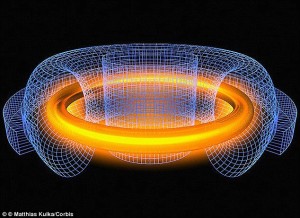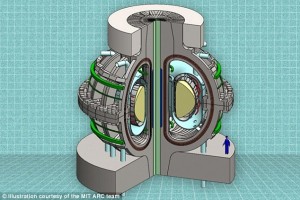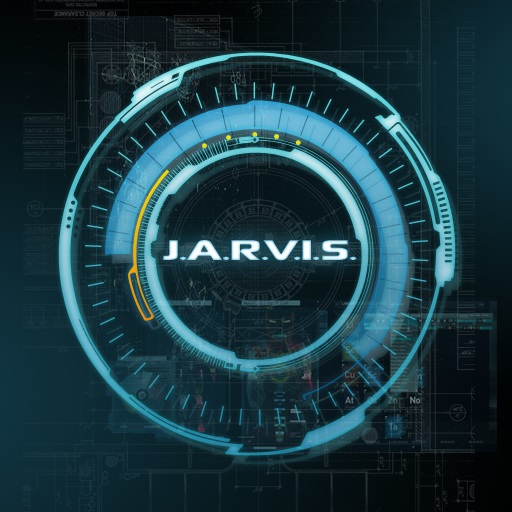
One of the most promising reactor designs is the tokamak reactor, which is a hollow metal chamber in the shape of a donut and twisted into a figure eight. The fuel is heated to temperatures in excess of 150 million°C, forming a hot plasma that can potentially generate limitless amounts of energy.
Well, for the most part anyway- read on for the details below:
“Fusion power could be here in less than a decade: MIT reveals small ‘Iron Man’ reactor it claims could create limitless amounts of energy
- The ARC planned reactor will be tokamak – or donut-shaped – system
- It could generate the same amount of energy as much larger designs
- It will used superconductors made of rare-earth barium copper oxide
- The stronger magnetic fields generated are able to better contain plasma, allowing the reactor to be smaller, cheaper and quicker to build
Fusion reactors that could provide a limitless source of energy could be a reality in less than a decade.
This is according to scientists at the Massachusetts Institute of Technology who claim to have come up with a commercially viable fusion reactor design.

A cutaway view of the proposed ARC reactor. Thanks to powerful new magnet technology, the much smaller, less-expensive ARC reactor would deliver the same power output as a much larger reactor.
Named ARC, the planned reactor will be a tokamak – or donut-shaped – system and would generate the same amount of energy as much larger designs – much like the reactor used by Tony Sratk in the hit movie Iron Man.
Fusion works by using two kinds of hydrogen atoms — deuterium and tritium — and injecting that gas into a containment vessel.
Scientist then add energy that removes the electrons from their host atoms, forming what is described as an ion plasma, which releases huge amounts of energy.
If the technique is perfected, it would provide an inexhaustible source of power and potentially solve the world’s energy crisis.
One of the most promising reactor designs is the tokamak reactor, which is a hollow metal chamber in the shape of a donut and twisted into a figure eight.
The fuel is heated to temperatures in excess of 150 million°C, forming a hot plasma.
Strong magnetic fields are used to keep the plasma away from the walls; these are produced by superconducting coils surrounding the vessel, and by an electrical current driven through the plasma.
Up until now, however, the magnetic coils responsible for producing the magnetic fields have proven to be a huge bottleneck in the process.
The ARC reactor is slightly different to other tokamak systems in that it uses new commercially available superconductors made of rare-earth barium copper oxide (REBCO) superconducting tapes.
The stronger magnetic fields generated by these coils are able to better contain superhot plasma, allowing the reactor to be smaller, cheaper and quicker to build.
The new reactor is designed for basic research on fusion and also as a potential prototype plant that could produce significant power.
The achievable fusion power increases according to the fourth power of the increase in the magnetic field.
This means, doubling the field would produce a 16-fold increase in the fusion power.
‘Any increase in the magnetic field gives you a huge win,’ said Brandon Sorbom, a MIT student working on the project.
While the new superconductors do not produce quite a doubling of the field strength, they are strong enough to increase fusion power by about a factor of 10 compared to standard superconducting technology.
This dramatic improvement leads to a cascade of potential improvements in reactor design.
The world’s most powerful planned fusion reactor, a huge device called ITER that is under construction in France, is expected to cost around $40 billion.

MIT PhD candidate Brandon Sorbom holds REBCO superconducting tapes (left), which are the enabling technology behind the ARC reactor. When it is cooled to liquid nitrogen temperature, the superconducting tape can carry as much current as the large copper conductor on the right.
With a major radius of 3.3 m (10.8 ft) and a minor radius of 1.1 m (3.6 ft), the ARC is a 500 MW reactor that is half the diameter of ITER.
Sorbom and the MIT team estimate that the new design would produce about the same power at a fraction of the cost.
But despite the difference in size and magnetic field strength, the proposed reactor, is based on ‘exactly the same physics’ as ITER.
Right now, as designed, the reactor should be capable of producing about three times as much electricity as is needed to keep it running, but the design could probably be improved to increase that proportion to about five or six times, Sorbom says.
So far, no fusion reactor has produced as much energy as it consumes, so this kind of net energy production would be a major breakthrough in fusion technology, the team says.
The design could produce a reactor that would provide electricity to about 100,000 people, they say.
Devices of a similar complexity and size have been built within about five years, they say.
‘Fusion energy is certain to be the most important source of electricity on earth in the 22nd century, but we need it much sooner than that to avoid catastrophic global warming,’ says David Kingham, CEO of Tokamak Energy, who was not connected with this research.
‘This paper shows a good way to make quicker progress,’ he says.”
Source: DailyMail.co.uk


